Soto (food)
Soto (also known as sroto, tauto, or coto) is a traditional Indonesian soup mainly composed of broth, meat, and vegetables. Many traditional soups are called soto, whereas foreign and Western influenced soups are called sop.
| Alternative names | Sroto, Coto, Tauto |
|---|---|
| Course | Main course |
| Place of origin | Indonesia[1] |
| Region or state | Nationwide in Indonesia, and also popular in Malaysia, Singapore, Brunei |
| Associated national cuisine | Indonesia |
| Serving temperature | Hot |
| Main ingredients | Various traditional Indonesian chicken, beef, or offal soups |
| Variations | Rich variations across Indonesia |
 |
| This article is part of the series on |
| Indonesian cuisine Masakan Indonesia |
|---|
|
Ingredients |
|
Styles |
|
Holidays and festivals |
|
Related cuisines |
|
|
Soto is sometimes considered Indonesia's national dish,[2] as it is served from Sumatra to Papua, in a wide range of variations. Soto is omnipresent in Indonesia, available in many warungs and open-air eateries on many street corners, to fine dining restaurants and luxurious hotels.[3] Soto, especially soto ayam (chicken soto), is an Indonesian equivalent of chicken soup. Because it is always served warm with a tender texture, it is considered an Indonesian comfort food.[4][5][6]
Because of the proximity and significant numbers of Indonesian migrants working and settling in neighbouring countries, soto can also be found in Singapore and Malaysia, and has become a part of their cuisine.
Introduced to Suriname by Javanese migrants, it is part of the national cuisine of that country as well, where it is spelled saoto.[7]
History
In the Indonesian archipelago, soto is known by different names. In the local Javanese dialect, it is called soto, and the dish also reached Makassar where it is called coto. Soto is found to be most prevalent in Java, and suggested that the hearty soup was originated from that island, and over the years this dish branched off in an assorted array of soto varieties.[8]
Although soto was undoubtedly developed in the Indonesian archipelago and each region has developed its own distinctive soto recipes, some historians suggest that it was probably influenced by foreign culinary tradition, especially Chinese. Denys Lombard in his book Le Carrefour Javanais suggested that the origin of soto was a Chinese soup, caudo (Chinese: 草肚; pinyin: tsháu-tōo; literally "Tripe"), popular in Semarang among Chinese immigrants during colonial VOC era, circa 17th century.[9]
Another scholar suggests that it was more likely a mixture of cooking traditions in the region, namely Chinese, Indian, and native Indonesian cuisine.[10] There are traces of Chinese influence such as the use of bihun (rice vermicelli) and the preference for fried garlic as a condiment, while the use of turmeric suggests Indian influence. Another example is soto betawi from Jakarta uses minyak samin (ghee), which indicates Arab or Muslim Indian influences.[11] Another historian suggest that some soto recipe reflects the past condition of its people. Soto tangkar, which today is a meat soup, was mostly made from the broth of goat rib-cage bones (Betawi:tangkar) in the past because meat was expensive, or the common population of Batavia were too poor to afford some meat back then.[12] Soto recipes has been highly localized according to local tradition and available ingredients, for example in Hindu-majority island of Bali, soto babi (pork soto) can be found, since Hindu Balinese prefer pork while beef is seldom consumed, they also do not shared Indonesian Muslim halal dietary law that forbid the consumption of pork.
The meat soup dish influenced various regions and each developed its own recipes, with the ingredients being highly localized according to available ingredients and local cooking traditions. As a result, rich variants of soto were developed across Indonesia.
Varieties
The spread of soto in Indonesian archipelago was followed by the localization of Soto's recipe, according to available ingredients and distinctive local taste.[9] As the result, myriad soto recipes and variations can be found throughout Indonesia.
By regions
Some sotos are named based on the town or region where they are created:
- Ambon soto – made of chicken and broth, flavoured and coloured with turmeric, ginger, galangal, garlic, lemongrass, and loads of spices. Served with rice, the toppings are blanched bean sprouts, shredded chicken, vermicelli, chopped celery leaves, golden fried shallots, fried potato sticks, kecap manis (sweet soy sauce), hot sauce, and potato croquettes.
- Bandung soto – a clear beef soto that has pieces of white radish.[13]
- Banjar soto – spiced with star anise, clove, cassia and lemongrass, and sour hot sambal, served with potato cakes[13].
- Banyumas soto, sroto Banyumas or sroto Sokaraja – made special by its peanut sambal, usually eaten with ketupat.
- Betawi soto – made of beef or beef offal, cooked in a cow milk or coconut milk broth, with fried potato and tomato.
- Kediri soto – a chicken soto in coconut milk.
- Kudus soto – made with water buffalo meat due to local taboos of the consumption of beef.
- Lamongan soto – a popular street food in various Indonesian metropolitan areas, a variation of the Madura soto.
- Madura soto or soto Sulung/soto Ambengan – made with either chicken, beef or offal, in a yellowish transparent broth.
- Makassar soto[14] or coto Makassar – a beef and offal soto boiled in water used to wash rice, with fried peanut.
- Medan soto – a chicken/pork/beef/innards soto with added coconut milk and served with potato croqutte (perkedel). The meat pieces are fried before being served or mixed.
- Padang soto[14] – a beef broth soto with slices of fried beef, bihun (rice vermicelli), and perkedel kentang (fried mashed potato).
- Pekalongan soto or tauto Pekalongan[15] – spiced with tauco (a fermented miso-like bean paste).
- Semarang soto – a chicken soto spiced with candlenut, mixed with rice, perkedel, tempe, and often eaten with sate kerang (cockles on a stick) or tripes and quail eggs. Soto Semarang is also known as Soto Bangkong, named after Bangkong crossroad in Semarang.[16]
- Tegal soto or Sauto Tegal, almost same with Pekalongan soto spiced with tauco (a fermented miso-like bean paste). Sauto can be chicken soto, beef soto, or even beef offal.
By primary ingredient
Other sotos are named based upon their chief ingredient:
- Soto ayam[17] – chicken in a yellow spicy broth with lontong, nasi empit, ketupat (rice compressed by cooking wrapped tightly in a leaf, then sliced into small cakes), or vermicelli, commonly found in Indonesia, Singapore, and Malaysia. Some versions are prepared with cellophane noodles.[18][19]
- Soto ceker – a chicken foot soto, served in rather clear yellowish spicy broth soup, which uses spices including shallot, garlic, lemongrass, and turmeric that add the yellowish colour, served with of cabbage, celery, rice noodles, and garnished to taste with sambal, lime and soy.[20] Soto ceker is one of the popular street food in Jakarta, Bali, and most of major cities in Java. In street side warung or humble restaurants, soto ceker is usually offered as a variation of soto ayam.[21]
- Soto babat – a cow's or goat's tripe, served in yellow spicy coconut milk soup with vermicelli, potato, and vegetables, usually eaten with rice. It is commonly found throughout Indonesia.
- Soto kaki (lit. "foot soto") – made of beef cow's trotters; tendon and cartilage taken from cow's feet, served in yellow spicy coconut milk soup with vermicelli, potato, vegetables, and krupuk, commonly eaten with rice. It is a Betawi food and can be found in Jakarta, Indonesia.
- Soto tangkar – also Betawi specialty soto made of chopped goat or beef ribs (Betawi:tangkar) and beef brisket cooked in coconut milk soup spiced with turmeric, garlic, shallot, chili, pepper, candlenut, cumin, galangal, coriander, cinnamon, Indonesian bay leaf (daun salam), and kaffir lime leaf.[22]
- Soto mi (spelled mee soto in Singapore and Malaysia) – a yellow spicy beef or chicken broth soup with noodles,[23] commonly found in Indonesia, Singapore, and Malaysia. Bogor, Indonesia, is famous for its soto mi made with beef broth, kikil (cow's cartilage), noodles, and sliced risoles spring rolls.
- Soto babi – a pork soto from Hindu majority of Bali island.[24]
Accompaniments
The following accompaniments are often eaten alongside soto:
- Stewed quail eggs or chicken eggs
- Cockles on a stick (sate kerang)
- Skewered grilled tripes (sate babat)
- Skewered grilled chicken giblets, such as intestine, gizzard, and liver satay (sate ati ampela dan usus)
- Fried chicken giblets
- Prawn crackers, sometimes crushed and mixed with crushed fried garlic as koya in Madura or Lamongan soto
- Gnetum seed crackers (emping)
- Fried tofu or tempeh
- Mashed potato patties (perkedel)
- Mung Bean Sprouts (tauge/kecambah)
- Hot chili sauce (sambal)
- Sweet soy sauce
- Fried shallot (bawang goreng)
- Spicy fried grated coconut (serundeng)
- crackers (krupuk)
- Lime juice, sometimes replaced with vinegar
Ingredients
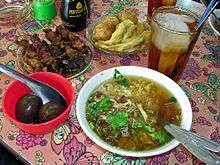
The meats that are most commonly used are chicken and beef, but there are also variations with offal, mutton, and water buffalo meat. Pork is seldom used in traditional Indonesian soto, however in Hindu majority Bali, soto babi (pork soto) can be found.[24] The soup is usually accompanied by rice or compressed rice cakes (lontong, ketupat or burasa). Offal is considered as a delicacy: the rumen (blanket/flat/smooth tripe), reticulum (honeycomb and pocket tripe), omasum (book/bible/leaf tripe), and the intestines are all eaten.
Other ingredients of soto include soun alternatively spelled as sohun or bihun (rice vermicelli), mung bean sprouts and scallion. Common soto spices include shallots, garlic, turmeric, galangal, ginger, coriander, salt, candlenut, and pepper.
The colour, thickness and consistency of soto soup could vary according to each recipes. Soto can have a light and clear broth just like soto bandung, a yellow transparent broth (coloured with turmeric) like the one that can be found in soto ayam, or a rich and thick coconut milk or milk broth just like those in soto kaki or soto betawi.
Soto in Malaysia and Singapore has a certain expected clear-soup look made of chicken broth, with spicy taste mixed with rice cubes.[25] It seems that soto served there derived from common soto ayam type with a clear and slightly yellow-coloured broth, pretty much similar to East Javanese soto lamongan or soto madura. Like many dishes, it may have been brought into the country by the many Javanese migrants in the early 20th century.
Gallery
- Soto ayam, chicken soto in soup with turmeric and spices
- Soto ambengan
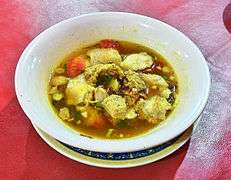 Soto babat, tripe soto
Soto babat, tripe soto- Soto babi, pork soto, a specialty of Balinese cuisine
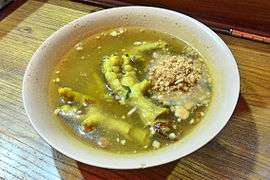 Soto ceker, chicken feet soto
Soto ceker, chicken feet soto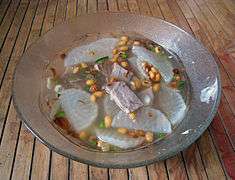
- Soto kaki mencos (cow's foot tendons soto), a Betawi specialty
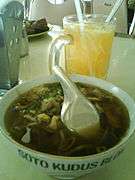 Soto Kudus, a type of chicken soto
Soto Kudus, a type of chicken soto- Soto Madura with egg
- Soto Sapi, beef soto from Yogyakarta
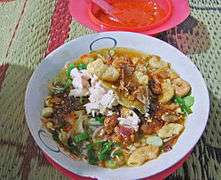 Sauto Tegal, chicken soto
Sauto Tegal, chicken soto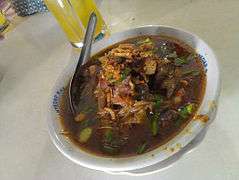 Tauto Pekalongan
Tauto Pekalongan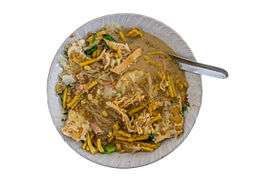 Soto Purwokerto
Soto Purwokerto- Sroto Sokaraja, Banyumas
- Soto Kediri
- Soto Padang, beef soto
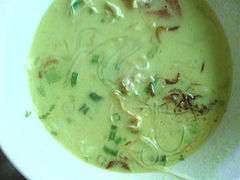 Soto Medan
Soto Medan- Soto Banjar
- Coto Makassar, beef soto
- Soto kambing, goat soto
See also
| Wikimedia Commons has media related to Soto. |
- Soto ayam
- Sop saudara, spicy Bugis-Makassar beef soup.
- Konro, Bugis-Makassar spicy cow's ribs soup, similar or related to ribs soto
- Tongseng, Javanese spicy mutton soup also related to soto
- Gulai, the Javanese gulai is soupy, similar to mutton or goat soto but slightly different in spices
- List of Indonesian soups
- List of soups
References
- "Indonesian Chicken Noodle Soup (Soto Ayam)". Food.com. September 26, 2006. Retrieved August 15, 2014.
- Media, Kompas Cyber. "Kemenpar Tetapkan 5 Makanan Nasional Indonesia, Ini Daftarnya - Kompas.com". KOMPAS.com (in Indonesian). Retrieved 2018-04-18.
- "A Soto Crawl". Eating Asia. March 21, 2009. Retrieved July 7, 2010.
- "Indonesia - Soto Ayam at Malioboro Country". Chowhound. October 29, 2011. Retrieved August 15, 2014.
- Sompotan, Johan (January 1, 2012). "Soto Siap Susul Rendang". Okezone.com. Retrieved August 15, 2014.
- "Indonesian Chicken Noodle Soup (Soto Ayam)". Food.com. September 26, 2006. Retrieved August 15, 2014.
- "Saoto Soup (Surinamese-Javanese)". multiculticooking.com. Retrieved April 29, 2013.
- Frederik, Claudine (30 June 2002). "Varieties of 'soto' to please all types of palates". The Jakarta Post. Retrieved 12 January 2015.
- Windratie (3 December 2014). "Jejak Akulturasi dalam Semangkuk Soto" (in Indonesian). CNN Indonesia. Retrieved 12 January 2015.
- Simatupang, Lono. Universitas Gadjah Mada Anthropology
- "'Cipratan' Luar Ke Dalam" (in Indonesian). Femina. Retrieved 1 February 2015.
- Endah Hulupi, Maria (22 June 2003). "Betawi cuisine, a culinary journey through history". The Jakarta Post. Retrieved 30 January 2015.
- Albala, K. (2011). Food Cultures of the World Encyclopedia. Food Cultures of the World Encyclopedia. Greenwood. p. 2-PA109. ISBN 978-0-313-37626-9. Retrieved February 1, 2015.
- Rsp. Fav. ala Cake: Sop & Soto (in Finnish). Gramedia Pustaka Utama. p. 5. ISBN 978-979-22-3106-9. Retrieved February 1, 2015.
- Erwin, L.T. (2008). 100 PTM: Sop & Soto. Gramedia Pustaka Utama. p. 6. ISBN 978-979-22-3908-9. Retrieved February 1, 2015.
- "Bertahan Sejak Zaman Belanda, Soto Bangkong Kini Jadi Ikon Kuliner di Semarang". Tribun Jateng (in Indonesian). 6 December 2016.
- Von Holzen, H.; Arsana, L. (2013). Authentic Recipes from Indonesia. Tuttle Publishing. p. 53. ISBN 978-1-4629-0535-5. Retrieved February 1, 2015.
- Harpham, Z.; Books, M. (2004). The Essential Wok Cookbook. Murdoch Books. p. 34. ISBN 978-1-74045-413-1. Retrieved Feb 1, 2015.
- "kumpulan resep soto ayam" (in Indonesian). resepsotoayam.com. Archived from the original on October 26, 2016. Retrieved August 15, 2016.
- "Soto Ceker Kuta Is a Local Legend". Qraved. January 21, 2015.
- "Gandaria street food satisfies palates of all". The Jakarta Post. Jakarta. 7 November 2015.
- "Resep Soto Tangkar" (in Indonesian). Bango. Retrieved August 15, 2014.
- Whitmarsh, A.; Wood, M. (2013). Jakarta: 25 Excursions in and Around the Indonesian Capital. Tuttle Publishing. p. 119. ISBN 978-1-4629-0893-6. Retrieved February 1, 2015.
- "Sup Babi ( Pig Soup ), Babi Guling Bu Rai Beras Merah" (in Indonesian). December 5, 2011. Retrieved August 15, 2014.
- Ariffin, Nadge (2 January 2009). "The Authoritative Soto". Friedchillies.com. Retrieved 2 February 2015.